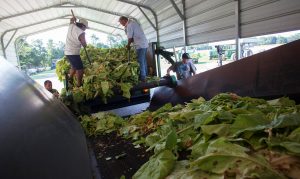
By Tom Polansek and P.J. Huffstutter
(Reuters) – As powerful Hurricane Florence crept closer to the southeastern United States on Tuesday, farmers in North Carolina rushed to harvest corn and tobacco and stock up on pig rations, while the danger of deadly flooding threatened a state where millions of farm animals are housed.
The forecasts for devastating rain and winds also had WH Group’s Smithfield Foods [SFII.UL], the largest U.S. pork processor, planning to shut two of its North Carolina plants – including the world’s biggest hog slaughterhouse.
Meanwhile, pig farmers across the state were lowering levels of liquid manure in outdoor storage pits in an effort to avoid a repeat of Hurricane Floyd. The 1999 storm flooded manure pits and contaminated waterways with animal carcasses and waste.

FILE PHOTO: Farm workers place harvested tobacco on a conveyor at Shelly Farms in the Pleasant View community of Horry County, South Carolina, U.S., July 26, 2013. REUTERS/Randall Hill/File Photo
North Carolina is the country’s leading producer of tobacco, second-biggest producer of hogs and a major poultry producer. Its crops include corn, soy and cotton, making agriculture the state’s No. 1 industry, valued at $87 billion.
“The governor said that North Carolina is the bull’s eye of this hurricane,” Larry Wooten, president of the North Carolina Farm Bureau, said in an interview. “I’ll tell you, agriculture is in the heart of that bull’s eye.”
Florence, a Category 4 storm with winds of 130 miles per hour (210 kph), was expected to make landfall on Friday, bringing heavy, sustained rain and potentially deadly flooding to the U.S. Southeast coast. Some 1 million people have been ordered to evacuate.
Two-thirds of North Carolina’s farm income comes from poultry and livestock, including hogs and dairy cattle, according to Wooten. The state has 8.9 million swine, 12 percent of the U.S. herd, U.S. Agriculture Department data showed.
In 2017, its farmers raised 830.8 million chickens for meat, 9 percent of the U.S. flock, and 32.5 million turkeys, or 13 percent of the U.S. total, according to USDA data.
It is unclear how many farm animals are in the storm’s path, according to both Wooten and the North Carolina Poultry Federation.
Two years ago, more than a million poultry birds died when floodwaters from Hurricane Matthew covered areas across central and eastern North Carolina. Carcasses were composted inside the houses where the birds were being raised.
More than 20 inches (51 cm) of rainfall are possible across eastern North Carolina, said Don Keeney, senior agricultural meteorologist for weather forecaster Radiant Solutions.
The approaching storm also prompted commodity handler Cargill Inc [CARG.UL] to make plans to close meat processing plants in West Columbia, South Carolina, and Dayton, Virginia, on Friday. Both Cargill and Smithfield said the plant closures were due to safety concerns.
CORN ‘ROUND THE CLOCK
Bo Stone, who raises corn and hogs in Rowland, North Carolina, said he worked into the night to harvest his crop to avoid damage from high winds. On Tuesday, rain halted his progress. “We’ve been running as hard as we can go,” he said.
Stone said relocating animals in the storm zone was not an option for many farmers. “Nobody would have the capacity to handle your animals,” he said.
Tall corn and tobacco crops are most vulnerable to wind damage and difficult to harvest if knocked down, said Rhonda Garrison, executive director of the Corn Growers Association of North Carolina.
“They’re around the clock on corn,” said Andy Curliss, chief executive officer for the NC Pork Council, an industry group.
North Carolina’s corn crop was 43 percent harvested as of Sunday, while the type of tobacco most commonly grown in the state was 67 percent harvested, according to USDA data.
North Carolina has waived transportation rules to help farmers move crops and livestock ahead of the most severe storm to threaten the U.S. mainland this year. “During harvest, time is of the essence,” Governor Roy Cooper said in announcing a state of emergency.
Altria Group Inc, the parent of Philip Morris USA, said the storm could potentially affect tobacco fields, and is exploring its crop-buying options to offset any losses. British American Tobacco’s Reynolds American, parent of R.J. Reynolds Tobacco, declined to comment.
North Carolina hog farmers have been spraying hog manure on farmland to lower the levels of waste in storage pits, known as lagoons, said Andrea Ashby, spokeswoman for the state’s Department of Agriculture and Consumer Services.
“The levels are in pretty good shape to handle the rain, but it all depends on how much rain we get,” Ashby said.
Most manure pits could handle up to 25 inches of rain, Curliss said.
Smithfield Foods said in a statement it has been lowering waste levels as necessary on its farms and encouraging farmers from whom it buys hogs to do the same.
(Reporting by Tom Polansek and P.J. Huffstutter in Chicago; Additional reporting by Julie Ingwersen in Chicago; Editing by Toni Reinhold and Matthew Lewis)


 The United Nations has called on the United States to end production of biofuel ethanol because of the current worldwide food crisis.
The United Nations has called on the United States to end production of biofuel ethanol because of the current worldwide food crisis.